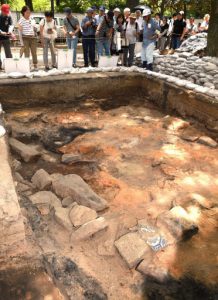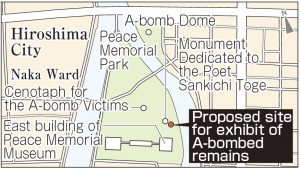Hiroshima City develops proposal for display of actual A-bombed remains from former Nakajima district, including construction of one-story exhibit facilities in Peace Park
Jan. 29, 2020
by Junji Akechi, Staff Writer
On January 28, it was learned that the city government of Hiroshima has developed a proposal for an on-site exhibit of actual A-bombed remains found in the former Nakajima district, including traces of residences of those who lost everything in the U.S. atomic bombing. The remains are buried under the Hiroshima Peace Memorial Park in Hiroshima’s Naka Ward. The city government is planning to construct a building for the exhibit and preservation of the remains, with replicas on display for some items. Hiroshima City plans to initiate the exhibit of such remains in fiscal 2020, the 75th anniversary of the atomic bombing, with the aim of having visitors gain deeper understanding of the inhumanity of the atomic bombings in conjunction with tours of the Hiroshima Peace Memorial Museum and other activities.
The site where the remains are to be displayed is now a green zone on the north side of the museum’s east building. It used to be part of the Tenjin-machi-suji area, which prior to the atomic bombing was lined with shops and houses. According to the city’s proposal, new one-story exhibit facilities will be established to allow visitors a glimpse of actual A-bomb remains such as burned and destroyed earthen walls of houses, rows of stones indicating boundaries between rooms or houses, and more. As carbonized tatami mats and wooden boards are considered fragile, the city plans to exhibit replicas of such items.
The facilities are intended to protect the remains from sunlight and rain. In the future, recreating the former Tenjin-machi-suji area, the city will also consider formation of a new pathway connecting facilities within Peace Park such as the museum, the building for the exhibit of remains, and the Hiroshima National Peace Memorial Hall for the Atomic Bomb Victims.
The former Nakajima district, once one of the busiest areas in Hiroshima, was devastated in the atomic bombing on August 6, 1945. After the end of the war, the district was covered over with soil to create Peace Memorial Park. The city conducted excavation work in that area twice between May and September 2019, confirming traces of homes, such as burned earthen walls and tatami mats. It was decided to exhibit such items because they could be used to convey the disastrous situation in which homes were destroyed and burned instantly.
The city will present its proposal in a meeting of an advisory board to be held in the city’s Naka Ward on January 29. Excavation work performed to date has failed to discover any other A-bombed objects such as rice ladles or bowls that could be directly connected to people’s lives at that time. Some former residents of the district have called on the city to continue excavation work based on the idea that it would be hard for visitors to accurately imagine the daily lives of victims without such items. Continued discussions will take place regarding how to display the remains more effectively to help visitors understand what A-bomb victims lost in the atomic bombing. By the end of this fiscal year, Hiroshima City plans to finalize the exhibit’s basic plan based on the advisory board’s opinions.
Keywords
Development of exhibit to display A-bombed remains from the former Nakajima district
Plans for the exhibit were developed by the Hiroshima city government to give visitors an idea regarding the lives before the atomic bombing of residents in the former Nakajima district, where Peace Memorial Park is now located, and the devastation caused by the U.S. atomic bombing. In 2018, an advisory board was established, comprised of seven committee members, including experts in architecture and archeology, A-bomb survivors, and representatives of citizens groups advocating preservation of A-bombed remains. The board has met to discuss excavation work and exhibit plans, among other topics.
(Originally published on January 29, 2020)
On January 28, it was learned that the city government of Hiroshima has developed a proposal for an on-site exhibit of actual A-bombed remains found in the former Nakajima district, including traces of residences of those who lost everything in the U.S. atomic bombing. The remains are buried under the Hiroshima Peace Memorial Park in Hiroshima’s Naka Ward. The city government is planning to construct a building for the exhibit and preservation of the remains, with replicas on display for some items. Hiroshima City plans to initiate the exhibit of such remains in fiscal 2020, the 75th anniversary of the atomic bombing, with the aim of having visitors gain deeper understanding of the inhumanity of the atomic bombings in conjunction with tours of the Hiroshima Peace Memorial Museum and other activities.
The site where the remains are to be displayed is now a green zone on the north side of the museum’s east building. It used to be part of the Tenjin-machi-suji area, which prior to the atomic bombing was lined with shops and houses. According to the city’s proposal, new one-story exhibit facilities will be established to allow visitors a glimpse of actual A-bomb remains such as burned and destroyed earthen walls of houses, rows of stones indicating boundaries between rooms or houses, and more. As carbonized tatami mats and wooden boards are considered fragile, the city plans to exhibit replicas of such items.
The facilities are intended to protect the remains from sunlight and rain. In the future, recreating the former Tenjin-machi-suji area, the city will also consider formation of a new pathway connecting facilities within Peace Park such as the museum, the building for the exhibit of remains, and the Hiroshima National Peace Memorial Hall for the Atomic Bomb Victims.
The former Nakajima district, once one of the busiest areas in Hiroshima, was devastated in the atomic bombing on August 6, 1945. After the end of the war, the district was covered over with soil to create Peace Memorial Park. The city conducted excavation work in that area twice between May and September 2019, confirming traces of homes, such as burned earthen walls and tatami mats. It was decided to exhibit such items because they could be used to convey the disastrous situation in which homes were destroyed and burned instantly.
The city will present its proposal in a meeting of an advisory board to be held in the city’s Naka Ward on January 29. Excavation work performed to date has failed to discover any other A-bombed objects such as rice ladles or bowls that could be directly connected to people’s lives at that time. Some former residents of the district have called on the city to continue excavation work based on the idea that it would be hard for visitors to accurately imagine the daily lives of victims without such items. Continued discussions will take place regarding how to display the remains more effectively to help visitors understand what A-bomb victims lost in the atomic bombing. By the end of this fiscal year, Hiroshima City plans to finalize the exhibit’s basic plan based on the advisory board’s opinions.
Keywords
Development of exhibit to display A-bombed remains from the former Nakajima district
Plans for the exhibit were developed by the Hiroshima city government to give visitors an idea regarding the lives before the atomic bombing of residents in the former Nakajima district, where Peace Memorial Park is now located, and the devastation caused by the U.S. atomic bombing. In 2018, an advisory board was established, comprised of seven committee members, including experts in architecture and archeology, A-bomb survivors, and representatives of citizens groups advocating preservation of A-bombed remains. The board has met to discuss excavation work and exhibit plans, among other topics.
(Originally published on January 29, 2020)









